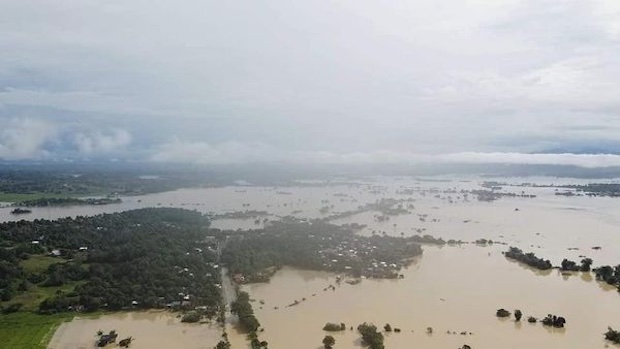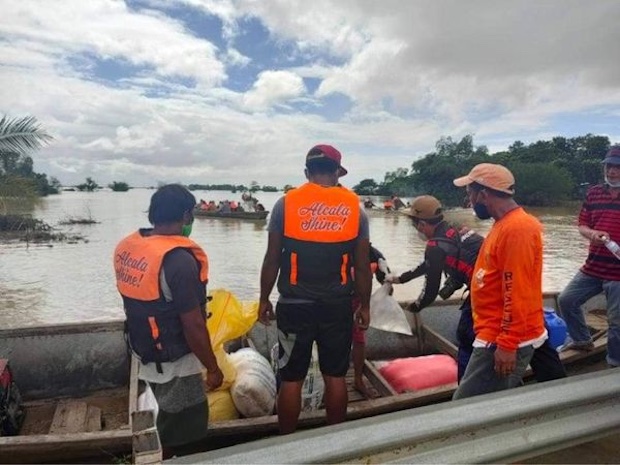
This photo, taken on Nov. 13, 2020, shows Baybayog-Pared-Baculod-Maraburab, Alcala National Highway rendered “unpassable” due to massive flooding. (Photo from the Facebook accoiun of Alcala Mayor Tin Antonio’)
MANILA, Philippines — It’s like the river claiming the whole of the land.
This was how Mayor Cristina “Tin” Antonio of Alcala town in Cagayan described the rushing waters that “completely” submerged homes during the onslaught of Typhoon Ulysses.
After the flood, which displaced around 4,600 families in the town, the local government started focusing on relief efforts.
“Return to normalcy, it’s going to take a long time. I am sure that the people would find that their homes are gone or destroyed,” Antonio told INQUIRER.net in a phone interview
“Their belongings, their crops are gone, their animals are gone. It’s going to take a long time for them to recover,” she added.
‘Domino effect’
While Alcala was spared from being directly hit by Typhoon Ulysses, it experienced rains brought about by a monsoon.
Adding to that is the water coming from areas directly hit by the typhoon.

This photo, taken Nov. 14, 2020 part of the relief operations being conducted for 25 barangays in Alcala. (Photo from the Facebook account of Alcala Mayor Tin Antonio)
“The typhoon hit Aurora so the rains were given… Imagine all that rain. All that rain goes to the streams and rivers and will end up in Magat Dam. So all this is upstream and then you have the Cagayan River which starts in [Nueva] Vizcaya and that becomes the conduit. You have Magat Dam and Isabela and that becomes the conduit of all these waters,” Antonio said.
“So Magat Dam has to release — because Magat Dam is also the recipient of water and rain coming from all over. So it’s a domino [effect]. So in a way, there is an indirect effect,” she added.
Further, she explained that the Cagayan River from being as wide as 400 meters “constricts” to only 180 meters in Alcala.
“It really is a bottleneck,” she said.
She added that in Alcala, the waters of Pared River coming from Baggao and the Sierra Madre joins the Cagayan River.
“The water level really rises because it’s the two bodies of water joining and then when that’s compounded by water coming from everywhere and you have a bottleneck, this is bound to happen,” she added.
Despite this, Antonio said it had been a challenge to convince residents to evacuate and to have them understand “the danger because people really didn’t expect that we would have this big a flood.”
“Although there was really a call for pre-emptive evacuation because the water was fast-rising, in a way people could not comprehend it because there was no typhoon signal [raised],” she said.
She added that while there were rains, it was “not enough” for residents to think that it would cause as high a flood as it did.
“It was difficult to explain why they had to evacuate. So there was hesitation on the part of the people because they did not comprehend that something of this magnitude could happen in a span of 11 months,” she said.
Antonio was referring to the flooding that happened in December 2019.
“That was almost like this, but it’s higher now,” she said in Filipino.
She said residents “couldn’t wrap their heads around the fact that this would happen again after 11 months.”
What had happened in December 2019, according to the mayor, was considered as a 100-year-flood or flood which has a one percent chance of happening in one year.
“People couldn’t imagine, even me, we couldn’t anticipate that this could happen again after 11 months,” she said.
Nevertheless, she said she already convened the local disaster management council to prepare its emergency measures as well as equipment and personnel a day before flooding started.
Long-term solution
Antonio said to address such severe flooding in Alcala, there had to be long-term solutions.
“It’s not something we can stop just like that because the problem is really deep-seated. The problem is denuded forests, denuded watersheds,” she added.
One of the recommendations to address the problem, which is based on a study by the UP Marine Science Institute requested by the local government, is to conduct a river channel widening.
A “massive” planting of native trees and a shift to agroforestry are also needed, she added.
Response amid pandemic
Antonio also said that the local government’s response to the calamity was faced with challenges brought by the pandemic.
“It’s very challenging because the threat of the virus spreading is really real,” she said.
The mayor said the 11 evacuation centers in Alcala have laid down health protocols, including mandatory antigen testing for at least one representative of a family.
Every one who took the test was so far negative, she added.
She also noted that each family has its own modular tent to separate them from other families and to curb any possible spread of the virus.
“We also appointed safety officers in each of the evacuation centers to go around to remind people to wear their masks properly. To disinfect the surrounding…It’s really orderliness and cleanliness and disinfection,” Antonio said.
What’s next?
With the floodwater receding and roads in the town already passable, Antonio said the local government had shifted its focus to relief operations.
“Things have somewhat settled down a bit. And everybody’s busy just adjusting to the situation…The next job would be cleaning up the debris, the roads, and of course taking care of the evacuees until it’s time for them to go back to what’s left of their homes,” she said.
According to Antonio, the evacuees will probably be able to return to their houses in the next two or three days.
“I think people will be able to go home in two or three days. There’s a concern here that they will go home as the water subsides so that they can clean their houses and get rid of the mud together with the water going down,” she said.
“There will be an exodus in two or three days’ time,” she added.
RELATED STORY
‘100-year flood’ returns to Cagayan Valley
[atm]

